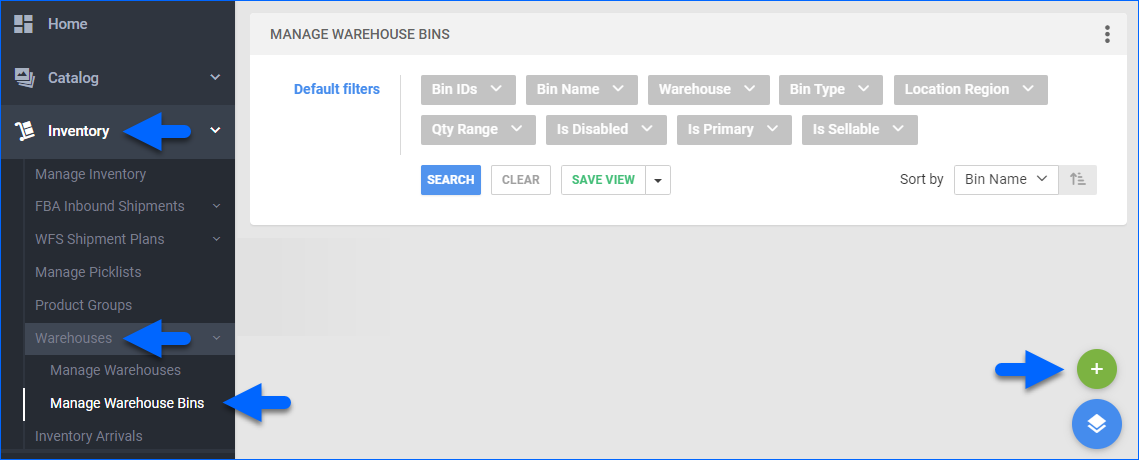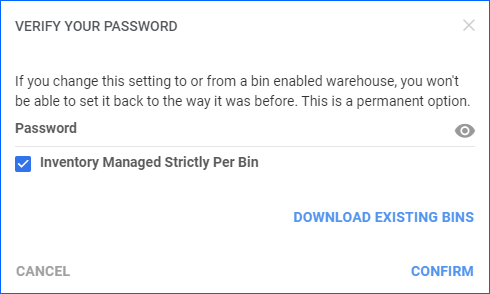Overview
In Sellercloud, Warehouses can be managed per bin. By default, new warehouses do not include bins, and products are simply stored in the warehouses,. By enabling the bin workflow, you get access to additional functionalities like sorting products, transferring inventory, and more.
The Enforce Bins on Selected Warehouses setting allows you to enable bin management for specific warehouses. Not all warehouses should include bins – for example, you should never enable bins for FBA warehouses.
Enable Bin Functionality
To enable or disable warehouse bin functionality for a warehouse:
-
- Go to Inventory > Warehouses > Manage Warehouses.
- Find and click the warehouse.
- Click Actions and select Enable/Disable Inventory managed strictly per bin.

- Optionally, you can click Download Existing Bins to download a spreadsheet with existing bins and products.
- Check or uncheck Inventory Managed Strictly Per Bin to enable or disable the setting.
- Enter your password and click Confirm. Note that this is a permanent option, and you can’t go back.
Create Bins
You can create bins from the Sellercloud interface or from your handheld Skustack device. You can also create bins in bulk from the Skustack Admin portal.
To create a new bin from Sellercloud:
- Go to Inventory > Warehouses > Manage Warehouse Bins.
- Click the Add New Bin icon.

- Complete the following details:
- Bin Is Sellable – Mark the bin as sellable or non-sellable. Product quantity stored in non-sellable bins is not included in the quantity available for sale.
- Bin Name – Enter the name of the bin. It’s recommended that you name your bins alphanumerically and avoid spaces in the name. Instead, use dashes (-) or underscores (_).
- Warehouse – Choose the warehouse to create the bin.
- Location Region – Choose the Location. Locations are physical areas or sections designated for specific purposes such as storage, packing, shipping, or receiving. Locations can be differentiated based on various factors such as product type, size, weight, or demand.
- Bin Type – Refer to the table below for a definition of each bin type.
- Location Notes – Add notes or warnings about the location.
- Primary Bin – Designate the bin as primary. Keep this box unchecked to create a secondary bin.
- Unit Capacity – Specify how many units can fit in this bin.
- Dimensions – Enter the bin’s physical dimensions.

Refer to the list below for a definition of each bin type:
- Normal bin – Regular bins where you store inventory.
- Assemble – When picking components to assemble Kit Products, they go into the assemble bin. When you assemble the kit, it is deducted from the assembly bin.
- DisAssemble – When disassembling a kit, you can choose a DisAssemble bin to put the items into.
- Picking – The picking bin is created by the system, with a unique picking bin for every warehouse. When an item is picked from a bin, it is automatically transferred to a Picking bin.
- PutAway – When creating a putaway list, all the products on the list get transferred to the putaway bin and are transferred out when put away.
- Receiving – When receiving RMA’s or POs, you can receive items in this bin before being transferring them to your normal storage bins.
- Temp – When assembling a kit, if you don’t specify where the kit should go, we put it into the temp bin.
Manage Bins
You can manage some aspects of your Warehouse bins directly from Sellercloud. However, we recommend doing it in the Skustack Admin Portal instead. To manage your warehouse bins:
-
- Go to Inventory > Warehouses.
- Click Manage Warehouse Bins > and search Search. Some actions will be available straight away, while others require selecting specific bins from the grid.
Bin Details Page
Click on a Bin ID or Name from the results grid to open the Bin Details page. The Details panel provides information about the warehouse, region and location of the bin, as well as its unit capacity and dimensions. You can also manage the Type the bin is set as, as well as whether the item quantities are to be considered sellable.
Additionally, the Bin Details page also offers the Items panel, which displayes all SKUs and their quantities currently in stock for the bin. You can quickly add new products, export them, transfer them to another bin, or manually adjust their inventory by clicking the respective icon.
The Actions menu provides additional options:
- Re-calculate Bin Physical Qty – manually force a recalculation the bin physical quantity. This is usually the first troubleshooting step in case of an inventory discrepancy or when you have made an adjustment by deleting an Order or FBA Shipment.
- Export to Excel – generates and downloads to your device an excel file containing all the Bin General Information.
The Toolbox offers further insights into your Warehouse Bin:
- Change Log – this page displays a history of all changes made to the bin details page, who made them, and when.
- Lot Numbers – this page is available when you have the Lot Number and Expiration Tracking workflow enabled. It displays all current Lot Numbers in the respective bin and gives you the option to export them.
- Movements – here you can view historical data of inventory coming into the bin and being removed. Each entry displays date, movement type, SKU, reason for the movement, and the user who initiated it.
Import Bins
On the Manage Warehouse Bins you have the option to Bulk Upload Bins from the Action menu. The pop-up dialogue offers two options: to update existing bins or create new ones. Each option comes with a downloadable template to help you format the file and streampline the process.
Bins Refill
Clicking on Primary Bins Need Refill from the actions menu will take you to a new page, where you will see Bins marked as Primary which currently hold negative inventory (for example, -10). Once you select a bin-enabled warehouse from the dropdown, the grid will display a list of products and the bin they are in, along with the quantity necessary to refill the bin and bring the inventory up to zero.
Export Options
From the Actions manu on the Manage Warehouse Bins page, you have a few Bin Export Options:
- Download All Bins – generates and downloads to your device an Excel file for all your existing Bins. The exported columns are Bin ID, Bin Name, Warehouse Name, Warehouse ID, Sellable, IsPrimary, Bin Type, Location Type, LocationRegion, Unit Capacity, Total Qty, and LocationNotes.
- Export Warehouse Bins – this option allows for a more focused export. In the pop-up dialogue you must choose a specific warehouse and you can further narrow down the exported results by selecting a specific product. The file columns are Warehouse Name, Bin Name, Product ID, Product Name, Qty Available, TotalValue, and Last Updated On.
Recalculate Bins
This action from the menu allows you to manually force a recalculation the bin Physical Quantity. You can select one or multiple entries from the grid. This action is usually the first troubleshooting step in case of an inventory discrepancy.
Print Bin Labels
Once you click Search on the Manage Warehouse Bins page, you can select any number of the results in the grid and download a pritable PDF file:
- Print Barcodes:
- Using Bin Names – prints one barcode per page, based on the Bin’s Name.
- Per Bin – prints multiple barcodes per page, along with their names. Ususally 39 barcodes, depending on their size and the length of the name.
- Print Barcodes (Per Bin) 30 / page – puts a limit on how many barcodes can be printed on a page, to a maximum of 30.
- Print QR Codes > Using Bin Name – the resulting PDF will contain QR codes generated based on the select bins’ names, one code oer page.
Disable or Re-Enable Bins
You can disable specific warehouse bins. Disabled bins are not usable and do not appear in any related options in Sellercloud or Shipbridge. You can re-enable disabled bins at any time, and they will become usable again immediately.
Note that you can’t disable a bin if it currently has a quantity of any product in it. To disable the bin, clear it out first by moving the quantity to another bin or warehouse.

